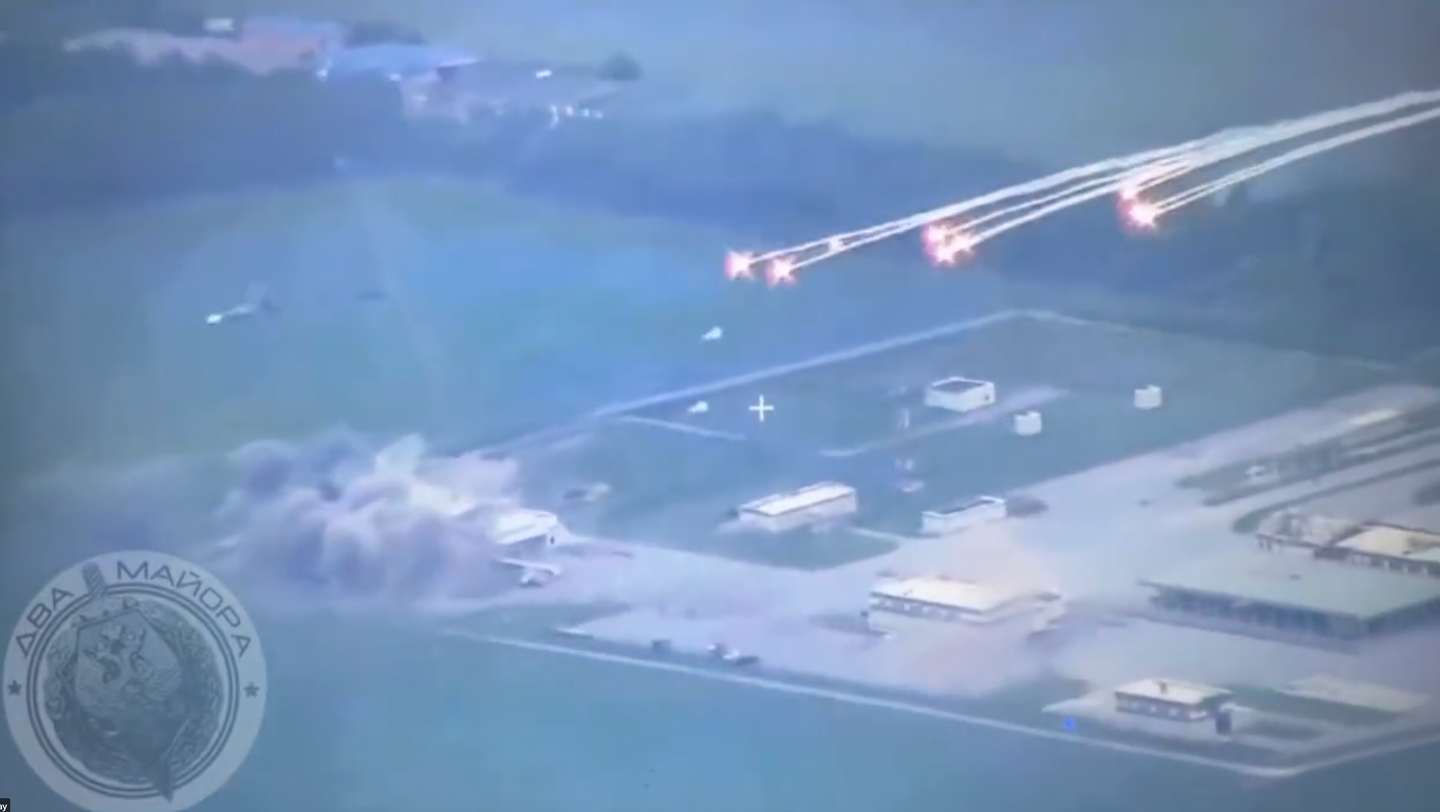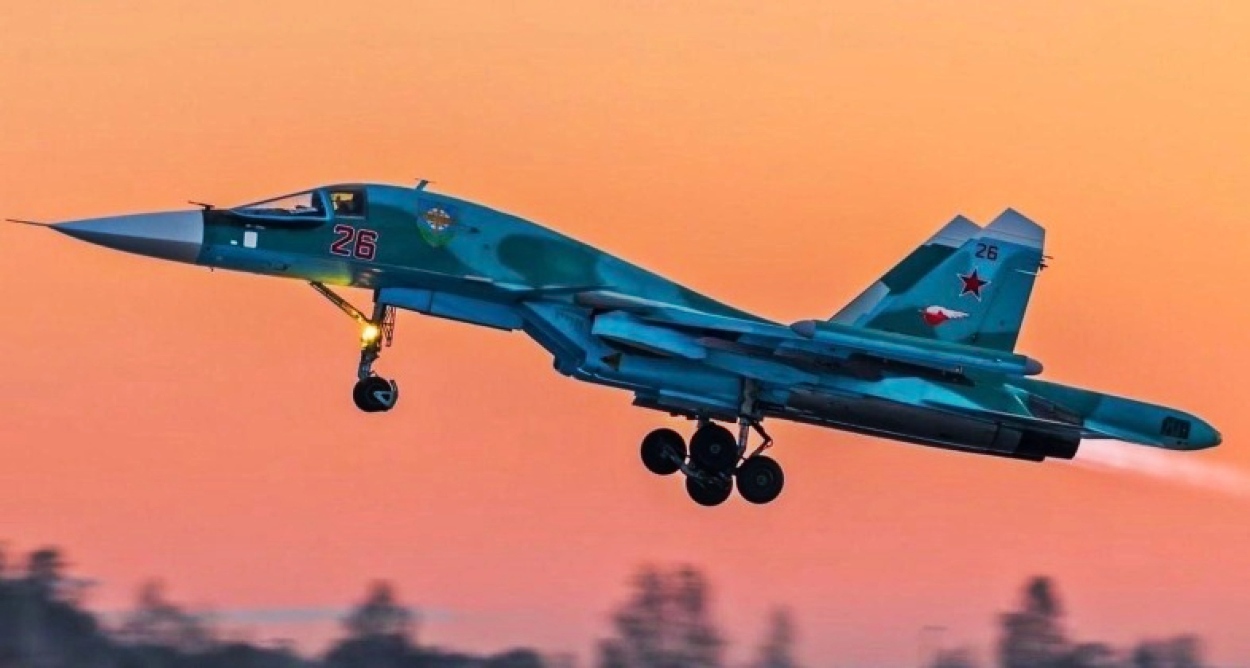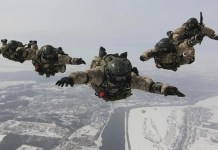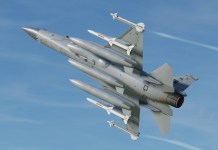Two Russian Su-34 Fullback fighter bombers were caught on camera dropping high-explosive bombs at a very low altitude near the Ukraine border but within mainland Russia.
MUST READ: ‘Better Suited’ Than F-16 Fighting Falcons, Ukrainian Fighter Pilots Could Finally Get Their Hands On JAS-39 Gripens
The video footage shows bombs failing to hit their targets, highlighting the challenges of using unguided bombs. According to the reports, a pair of Russian Su-34 bombers reportedly carried out air strikes on partisan forces at the Grayvoron checkpoint in the Belgorod region.
The Grayvoron settlement is about six miles inside Russia, but its checkpoint is on the Ukraine border. The Belgorod region shares a border of approximately 340 miles with Ukraine.
The bombs deployed by the Russian military aircraft were believed to be from the FAB-500Sh series, which are high-explosive freefall bombs specifically designed for low-altitude deployment.
Desperate air strike attempts by Russian Su-34 fighter jet on Ukrainian-backed forces who had settled at Grayvoron checkpoint in Belgorod region.
Su-34 flies at ultra-low altitude to drop high-explosive free-falling bombs.
The target was clearly not hit. pic.twitter.com/O4dL4CKgqj
— Clash Report (@clashreport) May 25, 2023
These bombs feature drag chutes that deploy right after release, ensuring the aircraft can safely move out of harm’s way before detonation. Additionally, equipped with specialized time delay fuzes, these bombs provide enhanced control and safety measures.
The video footage captures the sight of drag chutes in action and the impeccable timing of the time delay fuzes.
Guy Plopsky, a defense analyst, recently pointed out that the Su-34 aircraft have been utilizing parachute-retarded bombs to overcome the challenge of conducting strikes from medium and high altitudes due to the persistent threat of Ukrainian GBAD (Ground-Based Air Defense).
Thus, these specialized bombs are designed to be delivered effectively from very low levels, allowing Russian aircraft to navigate the operational constraints imposed by the Ukrainian defense systems.

In addition to the bombs, the Su-34 aircraft deploy an extra layer of defense by deploying infrared decoy flares. By deploying these, the Su-34s enhance their ability to thwart incoming heat-seeking threats, further enhancing their defensive capabilities during the mission.
While the Su-34 has been frequently observed operating over Ukraine, it is reportedly the first documented instance of the aircraft intentionally attacking targets within Russia.
However, there was an incident in April where a Su-34 mistakenly dropped a bomb or offensive weapon on the city of Belgorod, resulting in an unintended explosion and damage to multiple buildings.
Indian military expert Vijainder Thakur admits and says – leading channels have mocked Russian inability to strike targets precisely. The derision has been misguided. Glide bombs navigate using SATNAV (satellite navigation) with INS (inertial navigation system) fallback. SATNAV signals can be jammed, INS isn’t very accurate. US bombs wouldn’t’ do any better.
Su-34 Fullback Fighter-Bombers In Ukraine
Amid the ongoing full-scale invasion of Ukraine, the Russian Aerospace Forces have heavily relied on the formidable Su-34 aircraft, which has emerged as a dependable workhorse in their operations.
The United Kingdom’s Ministry of Defense (UK MoD) recently claimed that there are indications that Moscow is in the process of establishing an elite aviation attack unit known as ‘Shtorm.’
This unit is expected to combine Soviet-era Su-24 Fencer and Su-34 Fullback fighter bombers. Manufactured at the Novosibirsk Aviation Production Association (NAPO), the Su-34 stands out as one of the most high-priced tactical aircraft currently in operation.
Its elevated cost can be attributed to the inclusion of several sophisticated onboard systems that facilitate its primary role in conducting standoff-range bombing and precision strikes.

However, the Su-34 has not been immune to losses in the ongoing war. Open-source intelligence indicates that approximately 20 Su-34 aircraft were destroyed during the full-scale invasion due to both enemy actions and non-combat-related accidents.
These incidents underscore the extensive utilization of the Su-34 in the conflict and the intense airspace competition across significant parts of Ukraine.
Experts said utilizing low-altitude mission profiles combined with inadequate preparation renders the Su-34 highly vulnerable to enemy attacks.
This approach places the aircraft within the interception range of various short-range Man-Portable Air Defense Systems (MANPADS), including the US-manufactured Stinger.
There have been reports of a friendly fire incident on March 3, where Russia’s own Almaz-Antei S-300 missile allegedly shot down one Su-34. However, alternative sources credit the incident to a Ukrainian air defense unit.
Despite its capability to accommodate various guided munitions, including those with substantial standoff range, the Su-34 has been frequently observed utilizing “dumb” or unguided ordnance during numerous sorties in the ongoing Ukraine war.
Meanwhile, before the outbreak of the Ukraine war, the Su-34 had showcased its long-range weapons capabilities during its deployment in Syria.
The aircraft’s impressive performance in this role garnered attention and prompted Algeria to finally conclude prolonged negotiations by submitting a request to acquire 12 units of the Su-34.
- Contact the author at ashishmichel(at)gmail.com
- Follow EurAsian Times on Google News




